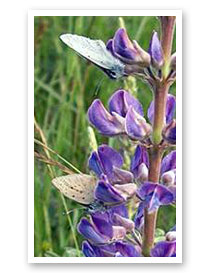Lupinus sulphureus
By Juliann Arvin
*please don't ingest
*if ingested get medical attention
https://www.flickr.com/photos/mark_leppin/5940469429/
Endangerment of Lupinus sulphereus
U.S. Fish and Wildlife Service listed Lupinus sulphureus Dougl. Ex Hook. Ssp. kincaidii (C.P. Sm) L. Pillips as an endangered species on January
23, 2000 (7). A plant is considered endangered if it is or is likely to be at
risk of survival (1). Lupinus sulphereus
is currently facing risk of survival due to habitat destruction,
competition from non-native plants and the elimination of historical
disturbance regimes (7).
- Agriculture as well as human development is causing habitat fragmentation of Lupinus sulphereus (6,7). Fragmentation is the breakup of habitat; meaning that there are still patches of exiting habitat but they are separated from each other (2). A once large population with genetic variability is reduced to smaller isolated populations with less genetic variability and a higher probability of inbreeding (5).
- Non-native plants are creating a competitive environment for space, nutrient, water and light resulting in habitat loss for Lupinus sulphereus (6, 7).
- Historically habitats where Lupinus sulphereus are found would periodically burn. This burning was an important part of the plants survival (6, 7). This burning has declined and with that an alteration of the habitat causing habitat loss for Lupinus sulphereus (6, 7).
Historical and
Current Habitat
Lupinus sulphereus is currently found in prairies in Northern Oregon to Northwestern Washington (6, 7). A prairie is “open native grasslands with little tree cover or the
grass land understories of savanna habitats” (7).
This map shows where Lupinus
sulphereus is currently found.
Lupin was once found in Vancouver Island, British Columbia
and Canada (7). Now populations are limited to certain locations in Washington
and Oregon (7).
Plant Lifecycle
Lupinus sulphereus is an herbaceous plant that can live for
many years (5). It begins flowering in April and last through June. It produces
purple flowers and when the flowers are fertilized they turn into pea pods.
Lupinus sculphereus can reproduce by seed or can spread by underground stems producing genetically identical plants (5). Pollinating insects for seed production include: bumblebees, solitary
bees, and honeybees (7). By mid-August this plant will have
died back.
This plant is vulnerable to seed damage, fruit and flower damage, and leaf and stem (7).
- Seed Damage (7)
Weevil Bruchid Beetle
- Fruit and flower damage (7)
Silver Blue Butterfly
http://butterfly-conservation.org/files/silver-studded-blue-upperwing-male1-keith-warmington-web.JPG
- Leaf and stem damage by "root borers, sap suckers and defoliator" (7)
Other Interesting
information
Lupinus sulphureus
provides habitat for the larvae of the Fender’s blue butterfly (6 & 7).
This butterfly is listed as an endangered species (3). Disappearance of this plant
will result in habitat loss for the butterfly.
Lupinus sulphureus contains chemicals that can be toxic (4). The potentness of the toxins will vary plant to plant (4). Younger plants normally contain more toxic chemicals then older ones (4). Although the seeds can be highly toxic (4).
Recovery Plan
Fish and
Wildlife has outline a recovery plan Lupinus sulphureus (7). This recovery plan
also includes the recovery of Fender’s blue butterfly, Erigeron decumbens var.
decumbens , Lomatium bradshawii, and Sidalcea nelsoniana (7). The goal of this
plan is to “achieve viable populations of the listed species distributed across
their historical ranges in a series of interconnected populations; this will be
accomplished by establishing networks of restored prairie reserves across the
geographic range of this recovery plan” (7). To achieve this goal 8 steps have
been outline:
Picture is a screenshot taken from: http://ecos.fws.gov/docs/recovery_plan/100629.pdf
The hope is that by
sometime in 2020-2030 Lupinus sulphereus will be delisted as an endangered
species (7).
Sources:
- "7 561. Endangered Plant Species; Definition; Conservation; Penalty Protection; Permits." (n.d.): n. pag. Web. 10 Mar. 2015. <http://www.emnrd.state.nm.us/SFD/ForestMgt/LE/documents/75-6-1.pdf>.
- "Benton County, Oregon." Benton County Prairie Species Habitat Conservation Plan. Benton County, Oregon, n.d. Web. 10 Mar. 2015. <http://www.co.benton.or.us/parks/hcp/kincaids_lupine.php>.
- Comstock, Amy, and Emma MacDonald. "Adventures in Conservation Research." : Lupinus Oreganus: Population Monitoring, Reintroduction Success and Evaluation of Experimental Treatments. The Institute for Applied Ecology, n.d. Web. 10 Mar. 2015. <http://research.appliedeco.org/2011/05/past-two-weeks-interns-split-up-with.html>.
- 4. Cook, D., ST Lee, D. R. Gardener, JA Pfisher, KD Welch, BT Green, TZ Davis, and KE Panker. "Result Filters." National Center for Biotechnology Information. U.S. National Library of Medicine, 25 Feb. 2009. Web. 11 Mar. 2015. <http://www.ncbi.nlm.nih.gov/pubmed/19182952>.
- Serverns, Paul M., Aaron Liston, and Mark V. Wilson. "Journal of Heredity Advance Access." Implications of Nonadventitious Rhizome Spread on Reproduction, Inbreeding, and Conservation for a Rare Grassland Legume (2011): 1-9. The American Genetic Association, 18 May 2011. Web. 10 Mar. 2015. <http://jhered.oxfordjournals.org/content/early/2011/05/18/jhered.esr034.full.pdf>
- U.S.Fish andWildlife Service.2006. RecoveryOutline for Lupinussulphureusssp.kincaidii.(Kincaid's Lupine). Portland,Oregon. 23 pp.
- U.S. Fish and Wildlife Service. 2010. Recovery Plan for the Prairie Species of Western Oregon and Southwestern Washington. U.S. Fish and Wildlife Service, Portland, Oregon. xi + 241 pp.









No comments:
Post a Comment